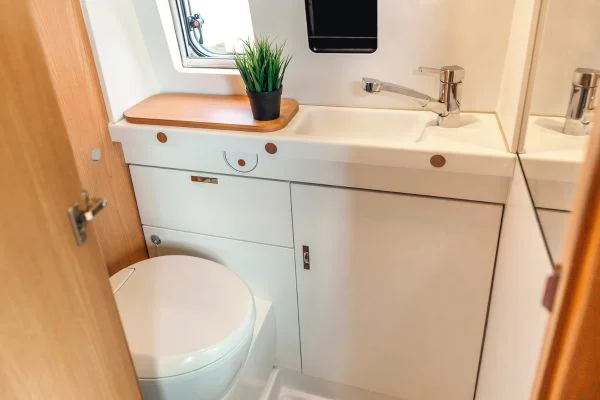Do you know how do camper toilets work? If you’ve ever gone camping, you might have noticed that the facilities are slightly different than what you’d find in your own home. Instead of a traditional toilet, many campers and RVs are equipped with a “camper toilet.” But have you ever wondered how these toilets work? Let’s delve into the inner workings of camper toilets to learn more about this unique plumbing system.
What Is A Camper Toilet?

A camper toilet is a self-contained system for disposing of waste and wastewater. It generally consists of two parts—the upper bowl, which collects solid waste, and the lower tank. It stores wastewater until it can be appropriately disposed of at an approved location. This system is designed to be easy to install and use while still providing enough capacity to hold waste for extended periods without needing to be emptied or serviced too frequently.
Anatomy Of A Camper Toilet
Most camper toilets are made up of four main parts. There is the toilet bowl, the waste-holding tank, a vent pipe, and an outlet pipe. The toilet bowl is where you do your business. The waste-holding tank is situated beneath or behind the toilet bowl. It holds all the contents flushed down the toilet until they can be disposed of properly.
The vent pipe is connected to both the holding tank and the outside air. It helps keep odors from infiltrating the interior of your RV or camper by allowing air to circulate between the two spaces. Finally, an outlet pipe connects to your campground’s sewage system (or septic tank) for easy disposal when you’re ready to move on from that location.
Read More: What Is A Vault Toilet Camping?
How Do Camper Toilets Work?

Cassette toilets are usually attached to a wastewater tank that collects all your human waste until it can be disposed of properly. When the tank fills up, you empty it at designated dumping stations (usually found at campgrounds).
It’s important to note that these tanks should never be emptied onto the ground as this can cause water contamination and harm local wildlife habitats. Instead, composting toilets use bacteria and enzymes that break solid waste into liquid, which is then evaporated into the air. This type of toilet doesn’t require any chemicals or water for cleanup. So they are more environmentally friendly than other types of toilets. Plus, they don’t require dumping stations for emptying, so they’re great for camping trips in remote locations!
Cleaning and Maintenance
No matter what type of camper toilet you have, regular maintenance is vital for keeping things hygienic and odor-free inside your van or trailer. Depending on how often you use your camper bathroom. You should clean it every few weeks using an antibacterial cleaner designed specifically for bathrooms (such as bleach or vinegar).
Additionally, if you have a cassette-style toilet, you should empty the wastewater tank regularly to avoid odors and potential messes inside your vehicle. Finally, ensure you always have plenty of spare parts if something breaks while you’re on the road!
Read More: How To Empty A Pop Up Camper Toilet?
Conclusion
We hope now you know how do camper toilets work. Camper toilets are an ingenious way for RV owners and campers alike to dispose of their waste without having access to traditional sewage lines or septic systems. By combining both bowl and tank systems with specialized features such as sensors, vents, filters, and pumps, these toilets provide convenience and sanitation while on the go!
So whether you’re planning your next camping trip or just curious about how these systems work. We hope this article gave you greater insight into how camper toilets operate!

